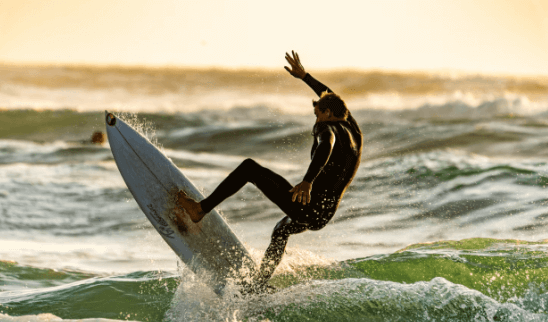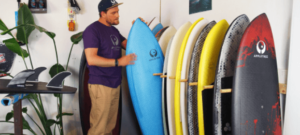Table of Contents
Have you ever thought of learning how to surf? Well, it’s never too late to try it out! Surfing is one of the good and fun things to do in life, and it’s a healthy way to stay active while enjoying the ocean waves and the great outdoors.
When you’re out on the water as the waves keep rolling in, you want to be one with the waves. There’s nothing like the thrill you experience when hopping into the water with your surfboard and ripping it up.
So, get yourself ready for an exhausting yet exciting surfing lesson! Capture your wave-catching moments, and don’t forget to share them online with the person surfing emoji with your family and friends!
It may be tough, but here are a few helpful tips for beginner surfers out there.
1. Select a soft, big board
For first-time surfers, you will need big boards. The bigger the surfboard, the more buoyant and stable it will be. It will maximize the waves you’re able to catch, thus, allowing you to practice your stance and pop up more.
Small, thin fiberglass boards are the best surfboards to use because they are very light, fast, and fluid on the waves. However, these aren’t for beginners. Better yet, opt for durable, big, soft-top ones, and great entry-level surfboards.
2. Scout the waves
It’s necessary to assess the weather conditions before you go surfing. Watch the ocean for at least 20 minutes before venturing out and at the same time, check the wave heights and how frequent the sets are. You also have to identify the rips and currents, so you’d know your limits and won’t find yourself too far outside your comfort zone.
Smaller and more gentle waves are best for beginners. Find a professional instructor who will teach you all about the sandbanks, tides, swells, winds, and other factors that affect the waves to learn to surf properly.
3. Position while paddling
As a person surfing for the first time, find the sweet spot in the middle of the board when paddling. You have to keep your toes positioned on the edge of the tail, not too far forward or back. Keep your body straight and raise your chin and chest to let your lower half and ribs take most of your body weight. This position will enhance your balance and allow you to have a stronger and better paddle stroke.
4. Practice your pop up
The initial pop-up might be the most challenging skill to master when learning to surf. Practice your pop-up on the sand, dig out a small hole for the fins, lay your stomach on the top of the board, and take it slowly. The secret to standing up on a wave is fluid and quick pop-up, like a controlled, fast push-up.
Using knees to pop up unbalances you and makes slow progress on your end. Don’t panic, and try to rush the pop-up using your knees. All you have to do is perfect the motion on the beach, and it will come easier when you surf. Be familiar with the feeling through practice.
5. Bend your knees
Another important tip for beginner surfers is to bend your knees and not your back when surfing. You have better balance with your knees bent, which lowers your whole center of gravity.
Also, with bent knees, you absorb any bumps you encounter along with the wave. Remember, the back bent is a plain bad style, and it pushes your head off-center from above the board. The head is the heaviest part of your body. Hence, keep your balance over the surfboard.
6. Leash up
No-leash surfers may look cool, but you should always wear a leash when you’re a beginner. It prevents your board from hitting other surfers and lets you catch more waves when you’re now swimming after your surfboard.
Attach the leash to your back foot with the rope pointing outwards, and keep it away from your ankle. Once the leash points in other directions, your feet will most likely get tangled, and you will make an ugly fall.
7. Fall flat
Let’s face it. You’re sure to fall when learning to surf for the first time. And when you do, the best way not to get an injury is to fall nice and flat. Never dive headfirst off your surfboard, and instead, try to flop onto your back or side. Jumping off feet first can also be dangerous because of the uneven nature of the seafloor. Thus, learn to fall flat.
8. Don’t duck dive just yet
Duck diving is not the best strategy to get past breaking waves for all beginner surfers. Try a turtle roll by grabbing the rails and flipping the board over so you’re underneath, which allows the whitewater to pass over you and the surfboard.
You can also stay on the board and push your body up over the wave so the whitewater can pass between your body and the board. When you have learned these skills, and you’re allowed to use a smaller board, then that’s the time you can do duck diving.
Must Read: How to Enjoy Every Minute of Your Travels | Guide to Enjoy Travel
9. Get the perfect timing
Through trial, error, and consistency, you will master the timing of catching a wave. It might be tough to achieve this right away for beginners, but you can make it happen with patience and effort. Once you decide to take a wave, look back and keep an eye on it. Start paddling to position yourself and tune into timing.
Takeaway
Surfing is one of the exciting water adventures you must try in life. You’re going to miss the thrill if you haven’t tried it even for once. There’s always a first time for everything, so it’s okay to make mistakes. These tips will help you get the hang of surfing.
Follow these and soak up in the water, and have some fun! You’re going to fall many times before catching a wave, but that’s perfectly fine. Everyone has to start somewhere, and practice makes perfect. So, get stoked and let the good time roll!














